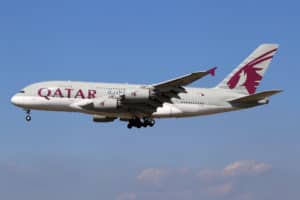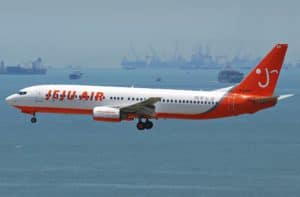The Airbus A380 and Boeing 737 are two of the most popular and successful commercial airliners in the world. Both planes have pros and cons, but which is ultimately better? This comparison will explore the similarities and differences between these two aircraft.
| Aircraft: | Airbus A380-800 | Boeing 737-800 |
|---|---|---|
| Photo: |
 |
 |
| Country: | France | United States |
| Manufactured: | from: 2007 to: Present | from: 1998 to: Present |
| ICAO: | A380 | B738 |
| Price: | $445.6 million | $89.2 million |
| Avionics: | Thales Rockwell Honeywell Combo | Rockwell Collins avionics |
| Engine: | 4x Engine Alliance GP7270 or Rolls-Royce Trent 900 | 2x Snecma / CFM56-7B27 |
| Engine Type: | Turbofan | Turbofan |
| Power: | 81,500 pound-force | 27,300 pound-force |
| Max Cruise Speed: |
587 knots 1,087 Km/h |
473 knots 876 Km/h |
| Approach Speed (Vref): | 135 knots | - |
| Travel Range: |
8,000 Nautical Miles
14,816 Kilometers |
3,060 Nautical Miles
5,667 Kilometers |
| Fuel Economy: |
0.1 nautical mile / gallon 0.049 kilometres / litre |
0.44 nautical mile / gallon 0.215 kilometres / litre |
| Service Ceiling: | 43,000 feet | 41,000 feet |
| Rate of Climb: |
1500 feet / minute 7.62metre / second |
- |
| Take Off Distance: |
2749 metre 9,018.92 feet |
2316 metre 7,598.33 feet |
| Landing Distance: |
1524 metre 4,999.94 feet |
1372 metre 4,501.26 feet |
| Max Take Off Weight: |
575,000 Kg 1,267,645 lbs |
384,039 Kg 846,652 lbs |
| Max Landing Weight: |
395,000 Kg 870,817 lbs |
- |
| Max Payload: |
87,000 Kg 191,800 lbs |
21,319 Kg 47,000 lbs |
| Fuel Tank Capacity: |
85,472 gallon 323,546 litre |
6,875 gallon 26,025 litre |
| Baggage Volume: |
190 m3 6,710 ft3 |
45.1 m3 1,593 ft3 |
| Seats - Economy: | 853 seats | 189 seats |
| Seats - Business Class: | 480 seats | 175 seats |
| Seats - First Class: | 416 seats | 162 seats |
| Cabin Height: |
3 metre 9.84 feet |
2.2 metre 7.22 feet |
| Cabin Width: |
6.58 metre 21.59 feet |
3.54 metre 11.61 feet |
| Cabin Length: |
50.68 metre 166.27 feet |
29.97 metre 98.33 feet |
| Exterior Length: |
72.73 metre 238.61 feet |
39.5 metre 129.59 feet |
| Tail Height: | 24.27 metre - 79.63 feet | - |
| Fuselage Diameter: |
7.14 metre 23.42 feet |
3.76 metre 12.34 feet |
| Wing Span / Rotor Diameter: |
79.75 metre 261.64 feet |
34.31 metre 112.56 feet |
| Wing Tips: | Wingtip Fences | No Winglets |
| More Info: | Airbus A380-800 | Boeing 737-800 |
|
Data presented is for entertainment purposes and should not be used operationally.
|
Other Airbus A380-800 comparisons:
Other Boeing 737-800 comparisons:
About the Airbus A380
The magnificent Airbus A380 made its debut on 25 October 2007, captivating all with its sleek design and fascinating features. It features an impressive range of 15,200 km and a lengthy 73 m body, along with a wingspan of an unbeatable 80 m. Its cargo capacity of 184 m³ is more than enough for most flights – both air cargo ones and those transporting passengers.
This greatest and biggest of planes flew for the first time on 27 April 2005, powered by the super awesome Rolls-Royce Trent 900 and Engine Alliance GP7000 engine types. With that sort of powerplant incentive, it made it through numerous rigorous tests leading up to its market launch.
Indeed, the Airbus A380 has won hearts and minds since then as one of the greatest engineering breakthroughs among flying machines.
Why was it developed and built?
The Airbus A380 was developed and built in response to the increasing demand for larger, more efficient airplanes. The need for a plane that could accommodate large numbers of passengers and cargo in a single flight was a key factor in the design process. The A380 also had to be designed with improved fuel efficiency, reduced operational costs, and advanced technology. To achieve these goals, the A380 was built with two full-length decks and four engines.
What purpose does it serve?
It served the purpose of an ultra-long-range airliner designed to fly the world’s busiest routes. Its immense size and capacity were well-suited for airports like Los Angeles and London Heathrow, which had maximum take-off weight restrictions.
The large capacity also made it ideal for airlines operating on routes with high demand, such as those between the United States and Asia.
About the Boeing 737
The Boeing 737 remains one of the most iconic aircraft ever to take flight. It was over 55 years ago that the first Boeing 737 set its wheels in the air on April 9, 1967, taking off from Renton, Washington, and beginning a legacy of efficiency and reliability. As one of the most popular jetliners ever built, it has been developed into three different models, with 11,177 copies produced as of October 2021.
First introduced commercially with Germany’s Lufthansa on February 10, 1968 (54 years ago), some of its primary users today include Southwest Airlines, Ryanair, and United Airlines – to name a few.
Since 1966, it has significantly impacted aeronautics, setting a new standard for passenger transport. There’s no denying the Boeing 737’s success story or its immense value in aviation history.
Why was it developed and built?
The Boeing 737 was developed to meet the needs of modern airline travel. Its design was based on the Boeing 707, which could not be further developed due to its size and complexity. The 737 was designed to be a smaller, simpler, and more efficient aircraft that could fly short-haul routes and accommodate up to 189 passengers.
What purpose does it serve?
It serves the purpose of a medium-range, single-aisle airliner designed for short to mid-range flights. The Boeing 737 is well-suited for regional and domestic flights, with a range of 3,000-7,200 km. It can also operate at smaller airports with shorter runways, making it more versatile than large-bodied aircraft like the Boeing 747.
How are the Airbus A380 and Boeing 737 different?
The Airbus A380 and Boeing 737 are the world’s most iconic aircraft. Both have tremendously impacted travel, but they differ in key ways. Most significantly, the A380 is much larger and heavier than the 737. It has a wingspan of nearly 80 meters compared to the 37 meters of the 737.
Additionally, the cockpit of an A380 accommodates three pilots, while that of a 737 can only fit 2.
Furthermore, while the A380 is typically used to transport large amounts of passengers over long-haul routes due to its greater cargo capabilities, the relatively short-range capacity of the 737 lends itself more aptly to short-term trips between locations that cannot accommodate larger aircraft.
How are the A380 and Boeing 737 similar?
Despite their differences, the A380 and 737 share some similarities. Both aircraft are designed with advanced technology to reduce fuel consumption and operational costs. Additionally, both planes feature two full-length decks, making them more efficient and allowing for larger passenger capacities.
Finally, both aircraft are equipped with engines designed to reduce engine vibration and noise, allowing for quieter flights.
What’s better about the Airbus A380?
Engine
The engines of the Airbus A380 are more fuel-efficient than those of its competitors, allowing it to travel farther and carry a greater payload. The engines also produce less noise and vibration, making the flight experience more comfortable for passengers.
Seating
The seating capacity of the Airbus A380 is larger than that of its competitors, allowing it to accommodate more passengers. The cabin layout allows for a greater personal space, with more legroom and wider seats.
Cargo
The cargo capacity of the Airbus A380 is greater than that of its competitors, with a total capacity of up to 150 tons. This allows the aircraft to carry more freight and larger payloads than other planes in its class.
Design
The design of the Airbus A380 is more aerodynamic than that of its competitors, allowing it to fly faster and more efficiently. The aircraft also has a greater range and higher ceiling, allowing it to reach more destinations with fewer stops.
What’s better about the Boeing 737?
Avionics
The avionics of the Boeing 737 is more advanced than those of its competitors, allowing for greater operational efficiency and safety. The aircraft boasts a wide array of sensors, instruments, and computers that provide pilots with faster and more accurate data.
Maintenance
The maintenance requirements of the Boeing 737 are lower than those of its competitors. This is due to modern materials and lubricants that reduce wear and tear on the aircraft, allowing for longer maintenance intervals and lower costs.
Conclusion
Traveling or buying an aircraft should be decided based on one’s needs and budget. On the one hand, Airbus A380 offers superior engine efficiency, seating capacity, and greater cargo capacity and aerodynamic design. On the other hand, Boeing 737 offers better avionics and lower maintenance costs, making it more economical. Ultimately, the decision is up to the consumer. Both aircraft are reliable and efficient options for long-haul travel or cargo transport.


